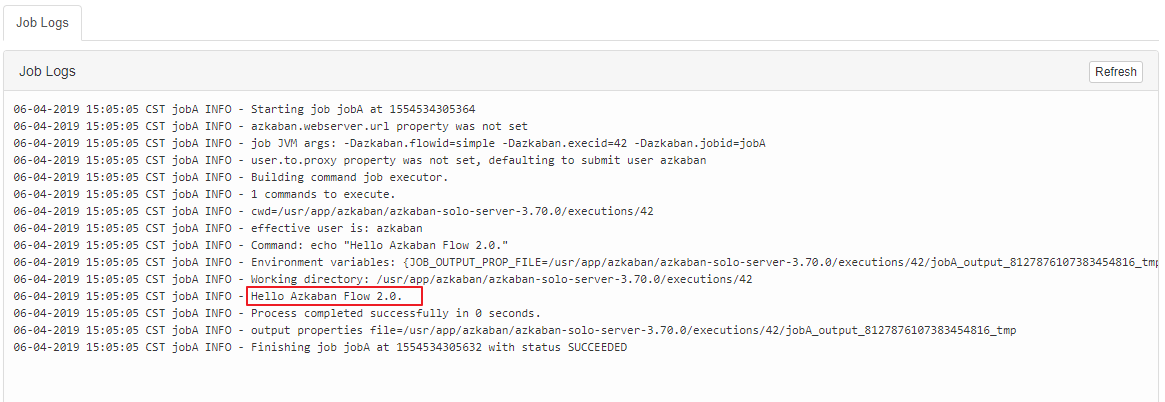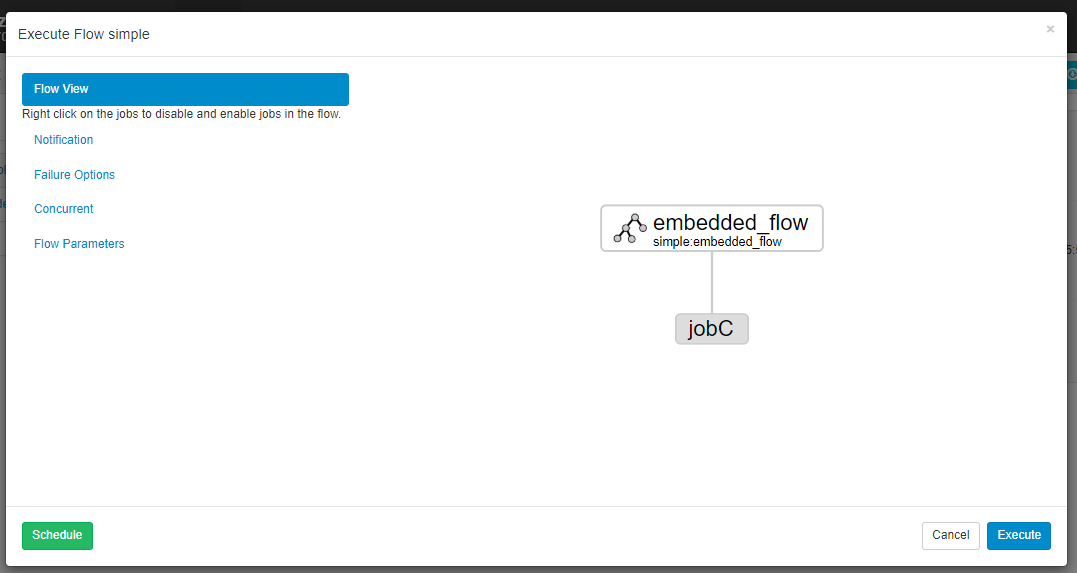分散式任務排程框架 Azkaban —— Flow 2.0 的使用
一、Flow 2.0 簡介
1.1 Flow 2.0 的產生
Azkaban 目前同時支援 Flow 1.0 和 Flow2.0 ,但是官方文件上更推薦使用 Flow 2.0,因為 Flow 1.0 會在將來的版本被移除。Flow 2.0 的主要設計思想是提供 1.0 所沒有的流級定義。使用者可以將屬於給定流的所有 job / properties 檔案合併到單個流定義檔案中,其內容採用 YAML 語法進行定義,同時還支援在流中再定義流,稱為為嵌入流或子流。
1.2 基本結構
專案 zip 將包含多個流 YAML 檔案,一個專案 YAML 檔案以及可選庫和原始碼。Flow YAML 檔案的基本結構如下:
- 每個 Flow 都在單個 YAML 檔案中定義;
- 流檔案以流名稱命名,如:
my-flow-name.flow; - 包含 DAG 中的所有節點;
- 每個節點可以是作業或流程;
- 每個節點 可以擁有 name, type, config, dependsOn 和 nodes sections 等屬性;
- 通過列出 dependsOn 列表中的父節點來指定節點依賴性;
- 包含與流相關的其他配置;
- 當前 properties 檔案中流的所有常見屬性都將遷移到每個流 YAML 檔案中的 config 部分。
官方提供了一個比較完善的配置樣例,如下:
config: user.to.proxy: azktest param.hadoopOutData: /tmp/wordcounthadoopout param.inData: /tmp/wordcountpigin param.outData: /tmp/wordcountpigout # This section defines the list of jobs # A node can be a job or a flow # In this example, all nodes are jobs nodes: # Job definition # The job definition is like a YAMLified version of properties file # with one major difference. All custom properties are now clubbed together # in a config section in the definition. # The first line describes the name of the job - name: AZTest type: noop # The dependsOn section contains the list of parent nodes the current # node depends on dependsOn: - hadoopWC1 - NoOpTest1 - hive2 - java1 - jobCommand2 - name: pigWordCount1 type: pig # The config section contains custom arguments or parameters which are # required by the job config: pig.script: src/main/pig/wordCountText.pig - name: hadoopWC1 type: hadoopJava dependsOn: - pigWordCount1 config: classpath: ./* force.output.overwrite: true input.path: ${param.inData} job.class: com.linkedin.wordcount.WordCount main.args: ${param.inData} ${param.hadoopOutData} output.path: ${param.hadoopOutData} - name: hive1 type: hive config: hive.script: src/main/hive/showdb.q - name: NoOpTest1 type: noop - name: hive2 type: hive dependsOn: - hive1 config: hive.script: src/main/hive/showTables.sql - name: java1 type: javaprocess config: Xms: 96M java.class: com.linkedin.foo.HelloJavaProcessJob - name: jobCommand1 type: command config: command: echo "hello world from job_command_1" - name: jobCommand2 type: command dependsOn: - jobCommand1 config: command: echo "hello world from job_command_2"
二、YAML語法
想要使用 Flow 2.0 進行工作流的配置,首先需要了解 YAML 。YAML 是一種簡潔的非標記語言,有著嚴格的格式要求的,如果你的格式配置失敗,上傳到 Azkaban 的時候就會丟擲解析異常。
2.1 基本規則
- 大小寫敏感 ;
- 使用縮排表示層級關係 ;
- 縮排長度沒有限制,只要元素對齊就表示這些元素屬於一個層級;
- 使用#表示註釋 ;
- 字串預設不用加單雙引號,但單引號和雙引號都可以使用,雙引號表示不需要對特殊字元進行轉義;
- YAML 中提供了多種常量結構,包括:整數,浮點數,字串,NULL,日期,布林,時間。
2.2 物件的寫法
# value 與 : 符號之間必須要有一個空格 key: value
2.3 map的寫法
# 寫法一 同一縮排的所有鍵值對屬於一個map
key:
key1: value1
key2: value2
# 寫法二
{key1: value1, key2: value2}2.3 陣列的寫法
# 寫法一 使用一個短橫線加一個空格代表一個數組項
- a
- b
- c
# 寫法二
[a,b,c]2.5 單雙引號
支援單引號和雙引號,但雙引號不會對特殊字元進行轉義:
s1: '內容\n 字串'
s2: "內容\n 字串"
轉換後:
{ s1: '內容\\n 字串', s2: '內容\n 字串' }2.6 特殊符號
一個 YAML 檔案中可以包括多個文件,使用 --- 進行分割。
2.7 配置引用
Flow 2.0 建議將公共引數定義在 config 下,並通過 ${} 進行引用。
三、簡單任務排程
3.1 任務配置
新建 flow 配置檔案:
nodes:
- name: jobA
type: command
config:
command: echo "Hello Azkaban Flow 2.0."在當前的版本中,Azkaban 同時支援 Flow 1.0 和 Flow 2.0,如果你希望以 2.0 的方式執行,則需要新建一個 project 檔案,指明是使用的是 Flow 2.0:
azkaban-flow-version: 2.03.2 打包上傳

3.3 執行結果
由於在 1.0 版本中已經介紹過 Web UI 的使用,這裡就不再贅述。對於 1.0 和 2.0 版本,只有配置方式有所不同,其他上傳執行的方式都是相同的。執行結果如下:

四、多工排程
和 1.0 給出的案例一樣,這裡假設我們有五個任務(jobA——jobE), D 任務需要在 A,B,C 任務執行完成後才能執行,而 E 任務則需要在 D 任務執行完成後才能執行,相關配置檔案應如下。可以看到在 1.0 中我們需要分別定義五個配置檔案,而在 2.0 中我們只需要一個配置檔案即可完成配置。
nodes:
- name: jobE
type: command
config:
command: echo "This is job E"
# jobE depends on jobD
dependsOn:
- jobD
- name: jobD
type: command
config:
command: echo "This is job D"
# jobD depends on jobA、jobB、jobC
dependsOn:
- jobA
- jobB
- jobC
- name: jobA
type: command
config:
command: echo "This is job A"
- name: jobB
type: command
config:
command: echo "This is job B"
- name: jobC
type: command
config:
command: echo "This is job C"五、內嵌流
Flow2.0 支援在一個 Flow 中定義另一個 Flow,稱為內嵌流或者子流。這裡給出一個內嵌流的示例,其 Flow 配置如下:
nodes:
- name: jobC
type: command
config:
command: echo "This is job C"
dependsOn:
- embedded_flow
- name: embedded_flow
type: flow
config:
prop: value
nodes:
- name: jobB
type: command
config:
command: echo "This is job B"
dependsOn:
- jobA
- name: jobA
type: command
config:
command: echo "This is job A"內嵌流的 DAG 圖如下:

執行情況如下:

參考資料
- Azkaban Flow 2.0 Design
- Getting started with Azkaban Flow 2.0
更多大資料系列文章可以參見 GitHub 開源專案: 大資料入門指南
